Porcelain Crowns and Bridges in Sugar Land, TX


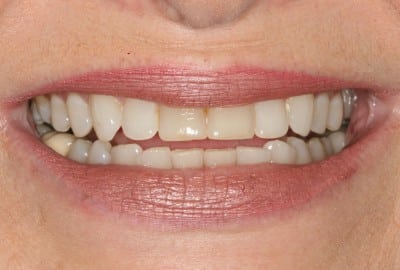
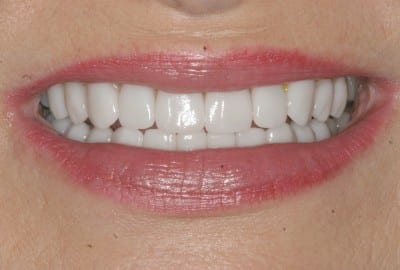
SmileTexas® Porcelain Veneers
Before and After
At SmileTexas® we use porcelain crowns and bridges to return strength to damaged teeth and to replace missing teeth. While the two are different dental prostheses, crowns are an integral part of every bridge. Both play a role in our Smile Makeovers.
We use only porcelain for our crowns and bridges, as it mimics the reflection characteristics of natural enamel and is exceptionally strong and durable. Our restorations will look completely natural and will give you renewed confidence. You’ll have a smile you’ll be proud to show off!
Dr. Davis and the staff were incredible! I never thought I’d enjoy a visit to the dentist so much. The staff always made me feel comfortable and reassured. I had a crown lengthening done and veneers and am very pleased! Would definitely recommend friends and family.
Excellent experience. The staff are the very best. Very caring and thorough. I would recommend SmileTexas® without hesitation. I am continued to be impressed by the professionalism of everyone there. I would smile for anyone now! Thank you.
What is a porcelain crown?
When a tooth either has extensive decay or inherent problems such as a crack or chip, we use a crown to return function and strength. A crown is a porcelain restoration that covers a cracked or chipped tooth to help your tooth function and gain back strength. In addition to damaged teeth, crowns can be used to cover misshapen teeth or to fill uneven gaps. They also serve as the anchors for dental bridges.
Benefits of Porcelain Crowns
In addition to their durability, porcelain crowns offer a variety of benefits:
- Aesthetics: Porcelain crowns are made to resemble your natural teeth, making them the perfect choice for dental repair and enhancement.
- Versatility: Porcelain crowns are widely used to correct broken teeth, misaligned and crooked teeth, and stained teeth.
What problems do porcelain crowns correct?
At SmileTexas®, we use porcelain crowns for these dental problems:
- Teeth with overly large fillings
- Severely worn teeth
- Chipped teeth
- Broken or fractured teeth
- Heavily decayed teeth
- Misshapen teeth
- Severely discolored teeth
- Teeth that have had a root canal
- Teeth on both sides of a bridge
Am I a Candidate for a Porcelain Crown?
Many adults receive a porcelain crown at some point in their lives. Reasons that porcelain crowns become necessary to include:
- A tooth has been severely damaged by decay or trauma.
- A root canal is needed to remove a deep infection from a tooth.
- Tooth loss is being treated with a dental implant and crown.
Porcelain crowns provide the structure that a tooth needs to be restored to its full integrity. Good candidates have sufficient tooth anatomy present to repair the damage that has occurred.
Are Porcelain Crowns Used in Cosmetic Dentistry?
Porcelain crowns are usually used in restorative dentistry, however, can also be used for cosmetic dentistry procedures as well. For instance, there are times when a tooth cannot be repaired with veneers or dental bonding, so a porcelain crown can restore the tooth.
How are porcelain crowns placed?
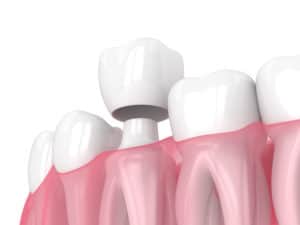 Placing a porcelain crown requires two visits. During your first visit, we prepare the tooth. Decayed or damaged areas of the tooth are removed and the tooth is thoroughly cleaned. To make room for the crown, we then shave off a portion of the tooth enamel. Following that, we take impressions and photos to send to the dental lab to create your porcelain crown. Fabrication takes about one week, and we place a temporary crown on your tooth in the meantime.
Placing a porcelain crown requires two visits. During your first visit, we prepare the tooth. Decayed or damaged areas of the tooth are removed and the tooth is thoroughly cleaned. To make room for the crown, we then shave off a portion of the tooth enamel. Following that, we take impressions and photos to send to the dental lab to create your porcelain crown. Fabrication takes about one week, and we place a temporary crown on your tooth in the meantime.
When your crown is finished you return for your second appointment. First, we check the fit and color match of your crown. We may make some minor adjustments to ensure the perfect fit. Then we cement the crown onto your tooth permanently.
How long does a Porcelain Crown procedure take?
It takes two separate appointments to get a porcelain crown. The first appointment involves preparing the tooth to receive its restoration. This appointment can take an hour to ninety minutes. After preparing the tooth, the dentist takes an impression to send to the dental lab. A temporary crown is then placed over the tooth that has been reduced. This prevents debris from damaging the softer tooth material and also minimizes the sensitivity one may experience. The temporary crown is affixed with dental cement only so patients need to avoid eating hard or sticky foods until they receive their final crown.
The second appointment involves removing the temporary crown and seating the restoration that will be in place for several years. This visit may also take about an hour. The dentist will evaluate the fit of the crown, ensuring that it fits well against adjacent and opposing teeth. If necessary, adjustments are made to the crown before it is bonded to the tooth.
How long do crowns last?
With proper care, there is no upper limit to how long porcelain crowns from SmileTexas® can last. Their lifespan is often contingent upon the health of the underlying tooth and surrounding gums, which will depend on your home hygiene.
Porcelain Crowns Maintenance near houston
Taking care of your dental crowns is pretty straightforward. Just like you usually would, make sure to brush and floss your teeth and dental crowns at least twice a day, and come into SmileTexas® every six months for preventative dental cleanings. If your crown chips or breaks at any point, schedule an appointment with our office and we will get it taken care of.
porcelain crowns VS porcelain veneers
Porcelain crowns and veneers are made of the same strong, stain-resistant material. The difference between the two tooth-coverings is that veneers are intended for cosmetic improvement, while crowns are made for restorative purposes. A crown covers the entire tooth that has been reduced and improves the functional structure of the tooth. A veneer covers only the front surface of a tooth, improving its appearance.
What are the risks of getting Porcelain Crowns?
Dental crown treatment is something that requires time and skill. Because the tooth is prepared to ensure the crown fits properly, there are risks for certain complications. These include:

- Sensitivity. The reduction that is necessary to accommodate a dental crown can leave a tooth vulnerable to lingering sensitivity to hot and cold temperatures. In most cases, this side effect resolves once the final crown has been seated.
- Nerve damage. A dentist works very carefully to avoid overstimulating the nerves at the center of the tooth. When a tooth has been injured or infected, the roots and nerves may be removed through root canal therapy.
Once a crown has been affixed to the tooth, there are minor risks of bite issues, crown damage or loss, gum irritation, and allergic reaction. The dentist takes time to carefully assess how the crown fits at the time of treatment to reduce the risk of bite issues and gum irritation. The careful bonding technology makes the risk of the crown falling off very low. Allergies are most often related to the use of metal crowns. The risk of an allergic reaction to porcelain crowns is very low.
Are Porcelain Crowns painful?
The dental crown procedure is not painful. Because the tooth is reduced to accommodate the crown, and this requires the use of a dental instrument that causes vibration, the dentist administers a local anesthetic into the tissue around the tooth. Patients may feel a pressing sensation on the jaw, but this is not painful. After the tooth is reduced and the anesthetic wears off, the area may be slightly sore or tender. Over-the-counter medication can be taken to manage comfort.
What is a porcelain bridge?
At SmileTexas®, we use porcelain bridges to literally “bridge the gap” between one or more missing teeth. A porcelain bridge is a dental prosthesis that is most commonly used to replace missing teeth and is cemented to either your natural teeth or implants surrounding the empty space. During this process, dental crowns are traditionally placed over your natural teeth on both sides of the gap to act as anchors to support the false teeth.
How is a porcelain bridge placed?
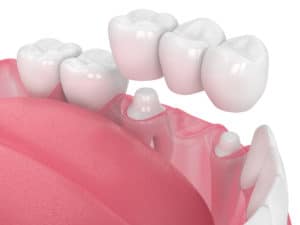 Placing a porcelain bridge requires two appointments. At first, the teeth on each side of the gap are prepared for their crowns. As described above, this involves removing some of the enamel to make room for the crown. Once this is done, we take impressions for the fabrication of your bridge.
Placing a porcelain bridge requires two appointments. At first, the teeth on each side of the gap are prepared for their crowns. As described above, this involves removing some of the enamel to make room for the crown. Once this is done, we take impressions for the fabrication of your bridge.
When the dental lab has finished your bridge, you return for the second appointment. We then test the fit and the color match with your adjacent teeth, making adjustments as necessary. Sometimes, we’ll place your new bridge with temporary cement to allow you to test the fit during normal use before we permanently cement it into place.
How long do bridges last?
With proper care, there is no upper limit to how long a dental bridge can last. The key is the health of the supporting teeth that secure the bridge.
How Do I Maintain Porcelain Crowns?
Proper maintenance and oral hygiene are essential in maintaining your porcelain crowns. You should brush and floss at least twice a day, using a soft-bristled brush. You should also use non-abrasive toothpaste as well.
Similar to regular dental checkups, you should also schedule follow-up appointments, so your dentist can examine your crowns to ensure they are in good repair.
Why Porcelain?
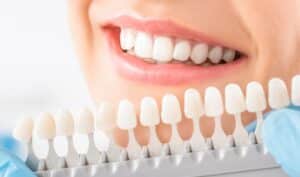 There are many benefits of both porcelain crowns and porcelain bridges. One of the biggest advantages is that porcelain is exceptionally durable and can last an entire lifetime in some instances. Additionally, porcelain is relatively affordable, safe for your mouth, and can even be matched to your existing teeth.
There are many benefits of both porcelain crowns and porcelain bridges. One of the biggest advantages is that porcelain is exceptionally durable and can last an entire lifetime in some instances. Additionally, porcelain is relatively affordable, safe for your mouth, and can even be matched to your existing teeth.
How do bridges compare with dental implants?
A bridge fills the gap from a missing tooth or teeth with a false tooth that covers down to the gumline but not below. Patients with bridges need to floss and clean beneath the false tooth to keep bacteria from building up. Bridges require that crowns cover the teeth on both sides of the gap to support the false tooth or teeth filling the gap.
A dental implant fully replaces a missing tooth. A dental implant is anchored by a titanium implant that is screwed down into the jawbone in the space formerly occupied by the tooth root. Then the jawbone is given time to accept and grow around the implant, making it a part of the jawbone. Following the healing process, a post is attached with a false tooth (crown) atop that. An implant replaces a missing tooth and doesn’t impact the adjacent teeth. Also, dental implants can last the remainder of the patient’s life.
Will My Porcelain Crowns & Bridges Look Natural?
Yes. One of the primary advantages of porcelain crowns and bridges is that the material is most similar to natural enamel. A porcelain crown is ideal for front-tooth restoration because, though strong, the porcelain is also transparent at the edges so will blend perfectly into your smile. The same is true for a porcelain bridge. What makes the outcome of your treatment aesthetically pleasing are the characteristics of the dental porcelain material and the nuances of the restoration, such as shape and size.
How Do I Prepare For the Porcelain Crown Procedure?
There will likely be no pre-treatment preparation to get your dental crown. This procedure is necessary because you have a tooth that has sustained significant damage, so the primary step before receiving your crown will be to reduce the natural tooth to remove all of the compromised structure. Your dentist will do this in the office after administering a local anesthetic. The process should not feel painful at all. If your dentist is concerned about infection, they may prescribe an antibiotic for you to begin taking days before your appointment. If there are any other recommendations, these will be discussed at your consultation.
What Is the Porcelain Crown Procedure Like?
The porcelain crown procedure is a multi-step process that involves a series of steps:
- Consult and Exam: At your initial visit, the dentist will examine your teeth to determine if porcelain crowns are right for you.
- Tooth Prep: To prepare your teeth for crowns, a small amount of enamel is taken from the tooth getting the crown.
- Impressions Taken: Impressions will then be taken of the prepared tooth and the tooth next to it. This serves as a model for your custom-made crown.
- Temporary Crown Placement: While the permanent crown is being made, a temporary crown will be placed to protect the tooth.
- Crown Placement: Once the porcelain crown is ready, the temporary ones will be removed. After the permanent crowns are approved, they will be bonded to the tooth.
Recovery and Aftercare For the Porcelain Crown Procedure
After receiving your temporary dental crown, you may need to avoid certain foods for a short time. For example, your dentist may advise you to refrain from chewing on hard foods like popcorn or pretzels until your final crown has been bonded to the tooth. It is not uncommon for the treatment area to feel sore or tender or for the tooth to feel sensitive during the process of getting a porcelain crown. To mitigate this, you may take an over-the-counter pain reliever as directed. You should continue to brush and floss normally while you have your temporary crown and also once you receive your final crown.
What Foods Should I Avoid After Getting a Porcelain Crown or Bridge?
Once you have your new porcelain crown or bridge, you want it to last as long as possible. Hard, crunchy foods are the biggest risk to your new restorations. Foods like ice should be strictly avoided. However, other crunchy foods, like carrots, may be enjoyed by cutting them into smaller pieces that break apart more easily with less forceful chewing. You may worry that you cannot eat steak or dense, chewy foods when you have a dental crown or bridge. Doing so does come with some risks. However, it’s low. As long as you take care to cut food into small bite-sized pieces, your crown or bridge should not be affected. Extremely chewy candy, like caramel, on the other hand, might create too much force and torque on a dental crown so should be avoided.
Will Porcelain Crowns Ruin My Teeth?
No. Your porcelain crown will be crafted using a precision that achieves an ideal fit over the damaged tooth as well as in between adjacent teeth and against the opposing tooth. Your crown will fit into your dentition just like your natural tooth had, thus preserving surrounding structures. In recent years, we have seen impressive advances in the composition and bonding techniques involved in porcelain crown treatment. Today, these types of dental crowns are considered to be comparable in strength to zirconia and other durable materials.
What should I expect at my Porcelain Crown consultation?
Porcelain crown consultations usually begin as a routine checkup and cleaning or an appointment that has been made to evaluate a toothache or injury to a tooth. First, the dentist performs a thorough examination of the tooth. X-rays may also be taken. This shows the extent of damage and indicates whether or not the root has been affected. After fully observing the tooth and the structures around it, the dentist discusses treatment options. Patients can expect to receive detailed information about their crown options, including the pros and cons of each.
Schedule a Consultation
To learn more about porcelain crowns or to schedule an appointment, call our SmileTexas® Sugarland office at (281) 265-7645. We look forward to making you smile!
